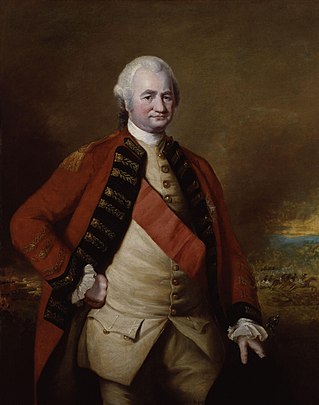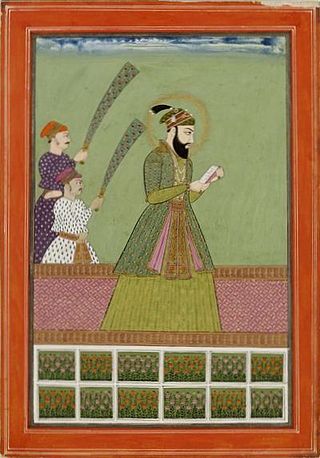
The War of the Austrian Succession was a European conflict that took place between 1740 and 1748. Fought primarily in Central Europe, the Austrian Netherlands, Italy, the Atlantic and Mediterranean, related conflicts included King George's War in North America, the War of Jenkins' Ear, the First Carnatic War and the First and Second Silesian Wars.

Robert Clive, 1st Baron Clive,, also known as Clive of India, was the first British Governor of the Bengal Presidency. Clive has been widely credited for laying the foundation of the British East India Company rule in Bengal. He began as a writer for the East India Company (EIC) in 1744 and established Company rule in Bengal by winning the Battle of Plassey in 1757. In return for supporting the Nawab Mir Jafar as ruler of Bengal, Clive was granted a jagir of £30,000 per year which was the rent the EIC would otherwise pay to the Nawab for their tax-farming concession. When Clive left India he had a fortune of £180,000 which he remitted through the Dutch East India Company.

Joseph Marquis Dupleix was Governor-General of French India and rival of Robert Clive.

The Battle of Plassey was a decisive victory of the British East India Company over the Nawab of Bengal and his French allies on 23 June 1757, under the leadership of Robert Clive. The victory was made possible by the defection of Mir Jafar, who was Nawab Siraj-ud-Daulah's commander in chief. The battle helped the British East India Company take control of Bengal. Over the next hundred years, they seized control of most of the rest of the Indian subcontinent, including Burma.

The Carnatic Wars were a series of military conflicts in the middle of the 18th century in India's coastal Carnatic region, a dependency of Hyderabad State, India. Three Carnatic Wars were fought between 1744 and 1763.

Mir Ahmed Ali Khan Siddiqi Bayafandi, Nasir Jung, was the son of Nizam-ul-Mulk by his wife Saeed-un-nisa Begum. He was born 26 February 1712. He succeeded his father as the Nizam of Hyderabad State in 1748. He had taken up a title of Humayun Jah, Nizam ud-Daula, Nawab Mir Ahmad Ali Khan Siddiqi Bahadur, Nasir Jung, Nawab Subadar of the Deccan. However, he is most famously known as Nasir Jung.

Santhome is a locality in Mylapore in Chennai city in India.
Charles Robert Godeheu de Zaimont was Acting Governor General of Pondicherry. He was the Commissioner of French army during Dupleix's reign.

Muhammad Ali Khan Wallajah, or Muhammed Ali, Wallajah, was the Nawab of the Carnatic from 1749 until his death in 1795.

Chanda Sahib was a subject of the Mughal Empire and the Nawab of the Carnatic between 1749 and 1752. Initially he was supported by the French during the Carnatic Wars. After his defeat at Arcot in 1751, he was captured by the Marathas of Thanjavur and executed.

The siege of Madras was a siege of Madras, which was then under British rule, between December 1758 and February 1759 by French forces under the command of Comte de Lally during the Seven Years' War. The British garrison was able to hold out until it was relieved.

Great Britain was one of the major participants in the Seven Years' War, which in fact lasted nine years, between 1754 and 1763. British involvement in the conflict began in 1754 in what became known as the French and Indian War. However the warfare in the European theater involving countries other than Britain and France commenced in 1756. Britain emerged from the war as the world's leading colonial power, having gained all of New France in North America, ending France's role as a colonial power there. Following Spain's entry in the war in alliance with France in the third Family Compact, Britain captured the major Spanish ports of Havana, Cuba and Manila, in the Philippines in 1762, and agreed to return them in exchange for Florida, previously controlled by Spain. The Treaty of Paris in 1763 formally ended the conflict and Britain established itself as the world's pre-eminent naval power.

The siege of Arcot took place at Arcot, India between forces of the British East India Company led by Robert Clive allied with Muhammad Ali Khan Wallajah and forces of Nawab of the Carnatic, Chanda Sahib, allied with the French East India Company. It was part of the Second Carnatic War.

France was one of the leading participants in the Seven Years' War which lasted between 1756 and 1763. France entered the war with the hope of achieving a lasting victory against Prussia, Britain, and their German allies and with the hope of expanding its colonial possessions.(1)

The First Carnatic War (1740–1748) was the Indian theatre of the War of the Austrian Succession and the first of a series of Carnatic Wars that established early British dominance on the east coast of the Indian subcontinent. In this conflict the British and French East India Companies vied with each other on land for control of their respective trading posts at Madras, Pondicherry, and Cuddalore, while naval forces of France and Britain engaged each other off the coast. The war set the stage for the rapid growth of French hegemony in southern India under the command of French Governor-General Joseph François Dupleix in the Second Carnatic War.
The siege of Trichinopoly (1751–1752) was conducted by Chanda Sahib, who had been recognized as the Nawab of the Carnatic by representatives of the French East India Company, against the fortress town of Trichinopoly, held by Muhammed Ali Khan Wallajah.

For other actions with this location, see Battle of Negapatam (disambiguation)
The Battle of Adyar took place on 24 October 1746. The battle was between the French East India Company men and Nawab of Arcot forces over the St. George Fort, which was held by the French. It was part of the First Carnatic War between the English and the French.

The siege of Pondicherry was conducted by British forces against a French East India Company garrison under the command of Governor-General Joseph François Dupleix at the Indian port of Pondicherry. The British siege strategy, conducted with inexperience in siege tactics by Admiral Edward Boscawen, was lifted with the arrival of monsoon rains, on 27 October 1748. The siege was the last major action of the First Carnatic War, as the Indian theatre of the War of the Austrian Succession is sometimes known.
The siege of Cuddalore was a battle during the War of the Austrian Succession on 17 June 1748.
















